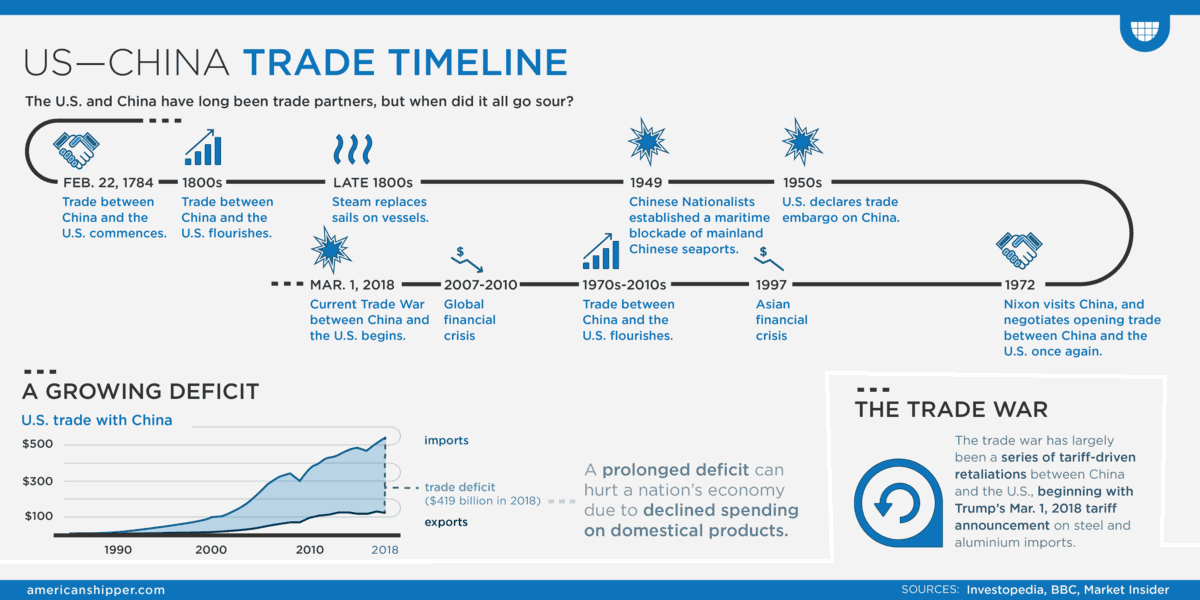Breaking The Deadlock: Understanding The US-China Trade Agreement

Table of Contents
Historical Context: The Path to the US-China Trade Agreement
The history of US-China trade relations is a complex narrative of both collaboration and confrontation. Early periods of engagement saw significant growth in bilateral trade, fueled by China's entry into the World Trade Organization (WTO) in 2001. However, this burgeoning relationship gradually soured, marked by increasing trade imbalances, concerns over intellectual property theft, and accusations of unfair trade practices.
Key events leading to the trade disputes included:
- Rising Trade Deficits: The US consistently ran large trade deficits with China, leading to accusations of unfair trade practices and currency manipulation.
- Intellectual Property Concerns: The theft of intellectual property and forced technology transfer became major points of contention, impacting US businesses and innovation.
- Tariffs and Retaliation: The imposition of tariffs by both the US and China, initially targeted at specific sectors, escalated into a broader trade war.
Examples of previous trade deals and attempts at resolution, while offering temporary reprieve, often failed to address the root causes of the tension:
- Bilateral Investment Treaty (BIT) negotiations: While never fully ratified, these negotiations aimed to improve investment conditions in both countries.
- Various rounds of trade talks: These often ended inconclusively, failing to resolve deep-seated structural issues.
- WTO dispute settlement mechanisms: These were utilized but proved insufficient in addressing the magnitude and complexity of the issues.
Key Provisions of the US-China Trade Agreement(s)
While the details vary slightly depending on the specific agreement(s) reached, several key provisions consistently emerge:
- Increased Market Access: The agreements aim to provide greater market access for US companies in China, particularly in key sectors such as agriculture, financial services, and manufacturing.
- Purchase Commitments: China committed to purchasing significant quantities of US goods and services, aiming to reduce the trade imbalance. This involved specific targets for agricultural products and manufactured goods.
- Intellectual Property Rights Protection: Stronger protections for intellectual property rights were a major focus, addressing concerns about theft and forced technology transfer. This included stricter enforcement measures and penalties for infringement.
- Dispute Resolution Mechanisms: Mechanisms for resolving trade disputes were established, aiming for a more predictable and transparent process than existed previously.
- Specific Areas of Collaboration: The agreements often included provisions for collaboration in areas such as technology transfer, standards development, and regulatory cooperation.
Economic Impacts of the US-China Trade Agreement
The economic consequences of the US-China trade agreement have been far-reaching and complex:
- Impact on US Jobs and Industries: While some sectors benefited from increased exports and market access, others faced challenges due to increased competition or supply chain disruptions.
- Effects on Chinese Economic Growth: The trade agreement had a mixed impact on Chinese economic growth, with some sectors experiencing setbacks due to tariffs, but others benefiting from increased domestic consumption.
- Changes in Global Commodity Prices: The trade dispute and subsequent agreements caused fluctuations in global commodity prices, impacting various industries worldwide.
- Shifts in Global Supply Chain Dynamics: Companies reassessed their supply chains in response to the trade tensions, leading to diversification and shifts in production locations.
Geopolitical Implications of the US-China Trade Agreement
The US-China trade agreement has significant geopolitical implications, extending far beyond purely economic considerations:
- Impact on US-China Relations Beyond Trade: The agreement's success (or failure) significantly impacts the broader relationship between the two countries, affecting diplomatic relations and strategic cooperation in other areas.
- Influence on Global Trade Organizations (WTO): The trade dispute and subsequent agreements have raised questions about the effectiveness of the WTO and the need for reforms in the international trade governance system.
- Implications for Other Countries’ Trade Relationships: The US-China trade tensions and subsequent agreements have influenced other countries' trade relationships and strategies, as they navigate their own relations with both powers.
- Potential for Future Trade Negotiations: The agreement serves as a precedent for future trade negotiations, setting the tone for how trade disputes might be managed in the future.
Future of US-China Trade Relations
The long-term prospects for US-China trade relations remain uncertain. While the current agreements offer a degree of stability, several factors could significantly influence the future trajectory:
- Potential for Future Trade Disputes: New areas of conflict, such as technological competition and national security concerns, could lead to new trade disputes.
- The Role of Technology in Shaping Future Trade Relations: Technological competition, especially in areas such as artificial intelligence and 5G, will be a major factor influencing future trade relations.
- Opportunities for Increased Cooperation: Despite tensions, opportunities for cooperation remain, particularly in addressing global challenges such as climate change and pandemics.
- The Impact of Global Economic Shifts: Global economic shifts, such as the rise of new economic powers and the impact of technological advancements, will impact the dynamics of US-China trade.
Conclusion: Navigating the Future of the US-China Trade Agreement
The US-China trade agreement is a multifaceted issue with profound economic and geopolitical implications. Understanding its historical context, key provisions, and potential impacts is crucial for businesses, policymakers, and global citizens alike. The future of the US-China trade relationship will likely be shaped by ongoing technological competition, geopolitical rivalry, and evolving global economic dynamics. Stay updated on the evolving landscape of the US-China trade agreement by following reputable news sources and engaging in informed discussions. Deepen your understanding of the complexities surrounding the US-China trade agreement by exploring further resources and analyses. The US-China trade relations will continue to define a significant portion of the global economic landscape for years to come, requiring constant vigilance and informed participation.

Featured Posts
-
 Ilia Topuria On Paddy Pimbletts Ufc 314 Hitlist A Breakdown
May 15, 2025
Ilia Topuria On Paddy Pimbletts Ufc 314 Hitlist A Breakdown
May 15, 2025 -
 Sergey Bobrovskiy Pyatiy Sukhar V Pley Off N Kh L
May 15, 2025
Sergey Bobrovskiy Pyatiy Sukhar V Pley Off N Kh L
May 15, 2025 -
 Tientallen Npo Medewerkers Beschuldigen Baas Van Angstcultuur
May 15, 2025
Tientallen Npo Medewerkers Beschuldigen Baas Van Angstcultuur
May 15, 2025 -
 Dodgers Muncy Breaks Silence On Arenado Trade Speculation
May 15, 2025
Dodgers Muncy Breaks Silence On Arenado Trade Speculation
May 15, 2025 -
 Pre Game Update Padres Vs Opponent Rain Delay Tatis And Campusano News
May 15, 2025
Pre Game Update Padres Vs Opponent Rain Delay Tatis And Campusano News
May 15, 2025
Latest Posts
-
 Ovechkin 12 E Mesto V Istorii N Kh L Po Golam V Pley Off
May 15, 2025
Ovechkin 12 E Mesto V Istorii N Kh L Po Golam V Pley Off
May 15, 2025 -
 Nhl Draft Lottery Rules A Source Of Frustration For Fans
May 15, 2025
Nhl Draft Lottery Rules A Source Of Frustration For Fans
May 15, 2025 -
 Analyzing The Backlash Nhl Draft Lottery Rules Under Fire
May 15, 2025
Analyzing The Backlash Nhl Draft Lottery Rules Under Fire
May 15, 2025 -
 Pley Off N Kh L Gol Ovechkina Ne Spas Vashington Ot Porazheniya
May 15, 2025
Pley Off N Kh L Gol Ovechkina Ne Spas Vashington Ot Porazheniya
May 15, 2025 -
 Why Are Nhl Fans So Upset About The Draft Lottery
May 15, 2025
Why Are Nhl Fans So Upset About The Draft Lottery
May 15, 2025
